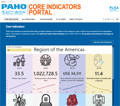
Montserrat - Territory Profile
The Health in the Americas+ country profiles are based on the interagency indicators available as of the dates referenced. The sources are referenced in this table. In some cases, the values of the indicators may differ from the most recent data available in the country.
Environmental and social determinants of health
In 2000 the total population of Montserrat was 5 138 inhabitants; by 2023 this figure had risen to 4 386, representing a 14.6% decrease. Regarding the country’s demographic profile, in 2023 people over 65 years of age accounted for 18.1% of the total population, an increase of 3.8 percentage points compared to the year 2000. In 2023, there were 90 women per 100 men and 144.7 older people (65 years or older) per 100 children under 15 years of age, as can be seen in the country’s population pyramids, distributed by age group and sex (Figure 1). Considering the population between 15 and 64 years of age to be potentially active (i.e., potential participants in the labor force), this group represented 69.5% of the total population of the country in 2023 (3 047 people). When we add these figures to the potentially passive population (548 under 15 years of age and 792 over 65 years of age), the result is a dependency ratio of 44 potentially passive people per 100 potentially active people. This ratio was 51.2 in 2000.
Life expectancy at birth in 2023 was 76.0 years, lower than the average for the Region of the Americas and 1.4 years higher that in 2000.
Figure 1. Population pyramids of Monserrat, years 2000 and 2023
Health situation
Maternal and child health
In 2020 the infant mortality in Monserrat was 0 deaths 1000 live births. The proportion of low-weight births (<2,500 grams) increased from 2% to 6% between 2004 and 2020.
Regarding the immunization strategy, measles vaccination coverage was 100% in 2022, an increase of 1 percentage points from 2000.
In relation to fertility, it is estimated that women have an average of 1.6 children throughout their reproductive lives. In the specific case of adolescent fertility, there was as increase 82.3%, from 27.5 live births per 1000 women aged 15-19 years in 2000 to 50.2 in 2022. In the period between 2011 and 2020, there was no variation in the percentage of prenatal care, which remained at 100%, and the percentage of births attended by trained personnel was 100% by 2020.
Figure 2. Infant mortality per 1000 live births, 1995–2020
Communicable diseases
In 2019, there were 0 new cases of Tuberculosis per 100 000 inhabitants in Montserrat. In turn, the rate of new HIV diagnoses per 100 000 inhabitants was estimated at 37.8 for the year 2017.
The sources of the interagency indicators used in this profile can be found in this table.
 For the latest data on health indicators for the Region of the Americas, be sure to visit the PAHO Core Indicators portal.
For the latest data on health indicators for the Region of the Americas, be sure to visit the PAHO Core Indicators portal.
Country COVID-19 Perspective
Status of the COVID-19 Pandemic
In Montserrat in 2020, there were a total of 13 cases of COVID-19, representing 2 931 per million population. In 2021, there were 33 identified cases, equivalent to 7 440 per million population. In 2022, there were 1 280 identified cases, equivalent to 288 570 per million population. In 2020, there were 1 death directly caused by COVID-19 in people diagnosed with the disease, or 225 per million population; in 2021, no deaths are reported. In 2022, 7 deaths directly caused by COVID-19 in people diagnosed with the disease, or 1 578 per million population. In 2020, Montserrat ranked 25th in the Region of the Americas in terms of the number of deaths from COVID-19, and 1st in 2022.
By December 31, 2021, 38% of the country's population had at least one dose of COVID-19 vaccine. As of April 20, 2022 (latest available data), 37% of the population was fully vaccinated. The vaccination campaign started on February 20, 2021, and so far 1 types of COVID-19 vaccines have been used in the country.
Figure 3. Cumulative COVID-19 deaths in the Region of the Americas, to July 29th, 2023
COUNTRY/TERRITORY PROFILES
Anguilla
Antigua and Barbuda
Argentina
Aruba
Bahamas
Barbados
Belize
Bermuda
Bolivia
Bonaire, Sint Eustatius, and Saba
Brazil (English) (Português)
Canada
Cayman Islands
Chile
Colombia
Costa Rica
Cuba
Curaçao
Dominica
Dominican Republic
Ecuador
El Salvador
French Guiana, Guadeloupe and Martinique
Grenada
Guatemala
Guyana
Haiti (English) (Français)
Honduras
Jamaica
Mexico
Montserrat
Nicaragua
Panama
Paraguay
Peru
Puerto Rico
Saint Kitts and Nevis
Saint Lucia
Saint Vincent and the Grenadines
Sint Maarten
Suriname
Trinidad and Tobago
Turks and Caicos Islands
United States of America
Uruguay
Venezuela
Virgin Islands (British)
Virgin Islands (U.S.)


